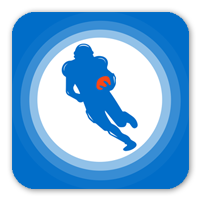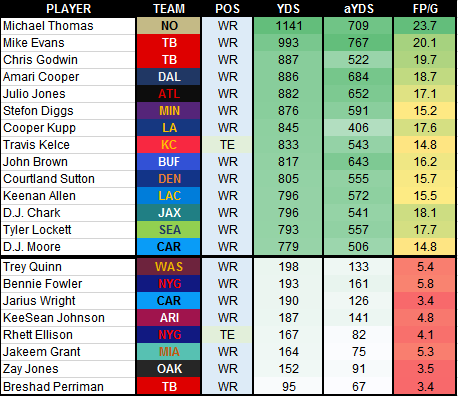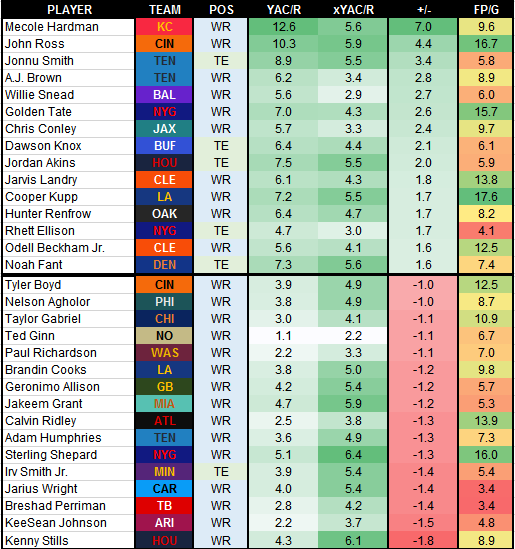Antonio Losada provides key fantasy football updates for wide receivers and tight ends, using Next Gen data to help fantasy owners make the best lineup and waiver wire decisions.
We've consumed our first "double-digit week" set of games. That means we've entered the final part of the season and, in fact, the fantasy football playoffs are closer than you may realize. There are just three more weeks to go until we hit Week 14 and celebrate our presence in the run for the chip, or lament the chances we lost along the way by falling short of making it to the final bracket. Now more than ever, no blunders are allowed. You have to know your weapons, have a strategy in place, and trust the leaders on the actual football field (the quarterbacks) to also be the leaders of your fantasy football teams.
To gain the biggest edge in your fantasy football league, it's necessary to understand how to apply the advanced statistics being used in sports nowadays. Back in the day, it was all about wins and losses, passing yards, and touchdowns scored. It's not that those stats are now worthless, they just don't offer enough information to savvy analysts. While football is still in its infancy compared to baseball in terms of analytics, the evolution the sport has seen lately in those terms is notable.
Each week, I'll be tackling NFL's Next Gen Stats, bringing you data from the previous week's games with notable takeaways you should consider when assessing fantasy players for the upcoming week. In case you're new to the series, or Next Gen Stats altogether, I recommend you read our preseason primer. Now, let's get to the data!
Be sure to check all of our fantasy football rankings for 2025:- 2025 fantasy football rankings
- Running back (RB) rankings
- Wide receiver (WR) rankings
- Quarterback (QB) rankings
- Tight end (TE) rankings
- Defense (D/ST) rankings
- Kicker (K) rankings
- FLEX rankings
- Dynasty rankings
State of WR/TE Entering the Final Stretch - NextGenStats
After spending three weeks analyzing NextGenStats data with the aim of determining the most and least impactful advanced stats in fantasy football (for running backs, quarterbacks, and wide receivers/tight ends), it's time to put knowledge to practice.
During the past two weeks, I've gone through the rushing and passing leaderboards. This week, we finally turn to wide receivers and tight ends and how NextGenStats are impacting their fantasy seasons up to this point. I'll present each of the stats from the NFL's advanced metrics site, its correlation with receiver fantasy points, a list of leaders and trailers in each category, and finally some notes and takeaways on both the players and the metrics' impact on fantasy as a whole.
So let's dive in. Note: The cutoff is set at 28 targets for both WR and TE.
Cushion / Separation
Correlation with Fantasy Points: negative-1% / negative-21%
Leaders and Trailers:
Leaderboard Notes:
- I have sorted the leaderboard by SEP just because it has a little higher relationship with fantasy points. As you can see, most of the players with high SEP values are tight ends. That comes down to them not being covered as tightly as other, more skillful receivers. Also, tight ends are often used as security blankets, so they're thrown passes only when they're quite open.
- Although most tight ends have high SEP marks, the best of them don't. Jared Cook (2.3), Zach Ertz (2.4), and Hunter Henry (2.6), just to name a few of the top-tier TEs, have all values in the low side of the table as they are covered tightly and treated as receivers.
- Up to 76 players among the 122 qualified are given a CUSH of more than six yards on average. Of those 76, just six are tight ends (Delanie Walker, Nick Boyle, Zach Ertz, Ryan Griffin, T.J. Hockenson, and Mike Gesicki).
- Only four tight ends are given a CUSH at or under five yards: Jack Doyle, Jared Cook, George Kittle, and Dawson Knox.
- The FP/G column in the table above, though limited in the number of entries it shows, already allows you to see how the negative 21% is present in the data in terms of the relationship between SEP and fantasy points per game. The bottom part of the table (low CUSH values) shows good FP/G players for the most part, while the top part of it has lower FP/G players.
- The top-10 players in FP/G all have SEP under 3.5, but from that point on it becomes a pretty random relation, thus the low 21% correlation. In fact, all of the 10-worst players in FP/G have SEP under 3.5 yards too.
Fantasy Takeaways:
- CUSH correlates to 21% with SEP: That is the strongest of relationships between CUSH and any other metric, basic or advanced. That tells you all you need to know about it in terms of fantasy football. CUSH is just a "style of play" metric, and although it has some descriptive power it won't help you discover any great talent to add to your team or make better fantasy decisions.
- SEP correlates to negative 54% with TAY: This is quite a strong relationship, and one to take into consideration as it is not so obvious. You might think that the more separation a receiver can get from his coverage, the more chances he'll have to make a catch if thrown a pass, and therefore why receivers that can separate often see the most targets and yardage through the air. That's actually mostly incorrect. Receivers with short separation from their coverage are usually more targeted, mainly because those are all stud receivers that are covered tightly but who keep being targeted and gain yards because of their talent.
- SEP correlates to 41% with YAC/R: Obvious relationship just included here because it is high enough. It comes naturally that a receiver that is able to separate from his defender will have more chances to rack up yards on the ground once he catches the ball, as he'd be out of the reach of his cover man and therefore free to run for extra yardage.
Correlation with Fantasy Points: 27% / 66%
Leaders and Trailers:
Leaderboard Notes:
- Opportunity trumps everything in fantasy football, and it can be seen in the highly related link between the percentage of yards a team/QB throws toward a player and the fantasy point he scores.
- As you can see in the table above, every player except one (Robby Anderson) with at least a 31% share of his team's air yards is scoring fantasy points in double-digits, and 12 of those 21 are averaging more than 15 points per game.
- On the other side of the table, this checks in the opposite direction: every player with a share under 11% is scoring in single digits with Mecole Hardman topping the list at 9.6 points per game.
- The lowest TAY% of a player averaging at least 10 fantasy points is 12.3% and it belongs to Sterling Shepard, who is averaging 16.0 fantasy points per game. Robby Anderson would be at the other end (35.2%, 7.3 FP/G) followed by Ted Ginn (26.8%, 6.7 FP/G).
- The position splits are, once again, very clear. No tight end is currently holding a share higher than 28% of his team's air yards. Mark Andrews leads the position with a share of 27.3%, followed by Zach Ertz (25.2%), Travis Kelce (24.7%), and Darren Waller (24.5%).
- Similarly, only three qualified wide receivers have a share of 10% or less through Week 11: Mecole Hardman (9.5%), Breshad Perriman (10%), and Jarius Wright (10%).
Fantasy Takeaways:
- TAY correlates to negative 42% with CTCH%: This says that receivers that are targeted with short passes normally have higher catch rates. In the leaderboards provided by the NFL, it shows that almost every top-20 player with low TAY values is a tight end. Most of them have catch rates of 70% or higher. That is because tight ends are often used on short routes and as safety valves by quarterbacks. The deeper the passes, the harder the catches as those plays tend to be riskier.
- TAY% correlates to 44% with TD: I found it really important to include this here, as some people still have the wrong idea of how the most used or thrown-to players are the ones expected to score the most points in real life--and therefore in fantasy football. While there is a good relationship between the number of yards "thrown" toward a receiver as a percentage of his team's total, that doesn't indicate that he's scoring touchdowns at the same high or low pace. Deep-threat receivers will gain a lot of yards for their teams but might not score touchdowns, while short route runners might be the ones getting those end zone passes for the TD. Don't get fooled by the TAY% metric and assume a high value there will automatically and steadily give you those extra points via TD.
Receptions / Targets / Catch% / Touchdowns
Correlation with Fantasy Points: 80% / 76% / 36% / 68%
Leaders and Trailers:
Leaderboard Notes:
- Not that you didn't know it already, but Michael Thomas keeps being ridiculous year after year. He's leading all wide receivers in receptions, yards, catch rate, and fantasy points per game. He's second in air yards (Mike Evans is first at just 58 yards over him), and only four players (all tight ends) have better catch percentages than him.
- Speaking of catch percentages, four tight ends lead the league: Irv Smith Jr. (84.4%), Austin Hooper (83.6%), Ryan Griffin (83.3%), and Kyle Rudolph (82.9%). You read it right, there are two Vikings there. In fact, Minnesota is the only team with four players in the top 27 in terms of catch rate (those two along with Stefon Diggs and Olabisi Johnson).
- Auden Tate (9.8 FP/G) is the only receiver averaging fewer than 10 fantasy points per game who has been targeted at least 65 times this season. He ranks 36th in targets, though, which means the top-35 players in targets all are averaging double-digit points per game. Again, volume is key!
- Only John Ross (16.7 FP/G), T.Y. Hilton (16.3), and Sterling Shepard (16.0) are averaging more than 15 fantasy points per game on fewer than 50 targets, though all of them missed time. If you want your receivers to give you points, you better make sure they're targeted often.
- The best "catchers" are not the most efficient fantasy players. Among WRs and TEs with the top-10 catch rates, the fantasy points per game they're scoring range from 5.4 (Irv Smith Jr.) to 23.7 (Michael Thomas). Not much going on there, as you can see (the correlation is just 36%, remember).
- In fact, two players (John Ross, 16.7 FP/G and Kenny Golladay, 16.0) have catch rates under 52% and are averaging WR2 scores through Week 11.
Fantasy Takeaways:
- REC correlates to 41% with CTCH%: Having more receptions doesn't entirely mean being better at catching the ball. Sure, the relationship is somewhat strong, but not impressive. As always, volume trumps everything...
- TAR correlates to 83% with aYDS: ...and that is why targets have a stronger relationship with "Air" Receiving Yards than their own receptions (83% to 81%). Keep going with volume and opportunity metrics over actual production ones. If the volume is there, production will come. If production is there on low volume, you'd be betting against the probable outcome, which doesn't happen often due to regression.
- CATCH% correlates to 29% with TD: I already talked about touchdowns and their relationship with other metrics above. In this case, we get back to the same problem as already stated. Even if a player catches everything, he might never be targeted in the end zone and therefore he won't score a single touchdown. On the other hand, any receiver can sustain a horrific catch rate and still score a lot of touchdowns if he happens to catch the balls thrown to him in the paint (this is an exaggerated and highly improbable profile of a player, but you get the idea).
- TD correlates to 56% with YDS, and to 57% with aYDS: As you can see, YAC is not that important when it comes to scoring touchdowns. Of course, YDS and aYDS are virtually equal for almost every player (the correlation between both metrics is up to 94%) but this means that you're not any better or worse analyzing any of those yardage metrics when trying to know what to expect in terms of touchdowns from any given receiver.
"Total" Yards (Air Yds + YAC) / "Air" Yards
Correlation with Fantasy Points: 88% / 82%
Leaders and Trailers:
Leaderboard Notes:
- Nothing surprising here, as receiving yardage is factored into the calculation of fantasy points without much hard math involved. Leaders in yardage average the most fantasy points, with the touchdowns and receptions just being a weekly bonus to their tallies.
- It is worth noting that Travis Kelce is the only tight end with more than 666 yards to his name. Darren Waller is in second with 666, followed by Zach Ertz (621), Austin Hooper (608), and Mark Andrews (600) as the only other players at the position with at least 600 yards through Week 11.
- Tyler Boyd (94 targets, 598 yards) and Larry Fitzgerald (76, 593) are the only receivers targeted more than 75 times to have fewer than 600 yards, therefore their low scoring averages.
- On the other hand, Stefon Diggs (65 targets, 876 yards) is the only receiver with 65 or fewer targets to have more than 661 yards. Mike Williams has 661 yards on 61 targets and Calvin Ridley has 614 in 64.
Fantasy Takeaways:
- YDS correlates to 88% with FP/G: You already knew this, basically because yardage gets factored into fantasy points one way or another no matter the scoring rules of the league you play. But hey, let me remind you something for the umpteenth time: volume is key. If a player is not being targeted he will find it hard to log receptions, let alone rack up yards. So yeah, focus on targets (76% correlation with FP/G) instead of pure yardage as a predictor of future success.
Yards After Catch / Expected YAC / YAC Above Expectation
Correlation with Fantasy Points: 4% / negative-5% / 11%
Leaders and Trailers:
Leaderboard Notes:
- Both Mecole Hardman and John Ross (until he fell injured) are having incredible seasons in terms of yardage gained after the catch. They're atop the leaderboard by a mile and are clearly exceeding the historic expectations. More than 50% of the receiving yards they have were achieved on the ground after catching passes thrown their way.
- As we saw above, tight ends are often given larger separations. That (and their strong body builds) allows them to gain more yards after the catch. In fact, five of the seven players with the highest YAC/R marks are tight ends. Looking strictly at "expected" numbers, the same is true: Of the 10 players with an xYAC/R mark at or above 6.0, five are tight ends.
- In relation to the positional splits, things change when looking at over and underperformers in terms of the YAC above expectation leaderboard. As you can see in the table (and expanding it to players with at least a 1.5 +/-), only five of 18 qualified receivers are tight ends. That is logical, as wide receivers are more agile and fast as to escape their cover man and gain more yards than the play situation indicates they should.
- Tight ends operate more on the historical as their abilities to gain yards after the catch are more limited. That is why of the 32 qualified tight ends, only eight are averaging YAC/R below expectations (+/- below zero).
- The percentage of yards after catch a player logs in comparison to his total yards doesn't correlate highly with his fantasy points (negative 21%), but the relationship is enough to consider YAC receivers volatile and not so safe as those who can get yardage strictly through the air.
- Among the 122-qualified receivers (WRs and TEs), those with at least 50% of their yards gained after the catch are averaging 9.8 points per game. Those between 50% and 30% are averaging 11.1 points. Those with fewer than 30% are averaging 11.3 points.
Fantasy Takeaways:
- YAC/R, and the whole "yards after catch" concept is rather useless in fantasy football. The relation between any of those metrics and the fantasy points scored by any receiver is almost non-existent and you can consider everything YAC related as just a small bonus to what the receiver is truly able to do on the field. Think about it: How many times does a player go for huge YAC runs in a full season, let alone a single game? There will be the eventual and random event, but those are the outliers and therefore should be discarded when analyzing players and just enjoyed when we're lucky enough to see them happen to one of our players.
That's it for today. Until we meet again next week, don't get too mad at the bye weeks, try to find the best free agents in your leagues' player pools, field the most productive teams you can, and win the weekend with all of your squads!





 RADIO
RADIO





























